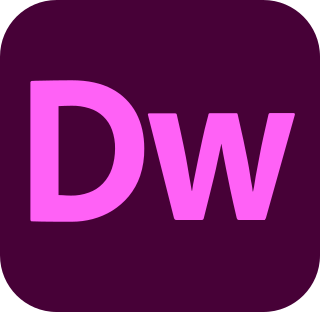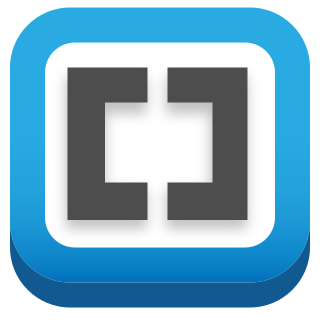
HyperCard is a software application and development kit for Apple Macintosh and Apple IIGS computers. It is among the first successful hypermedia systems predating the World Wide Web.
AppleScript is a scripting language created by Apple Inc. that facilitates automated control over scriptable Mac applications. First introduced in System 7, it is currently included in all versions of macOS as part of a package of system automation tools. The term "AppleScript" may refer to the language itself, to an individual script written in the language, or, informally, to the macOS Open Scripting Architecture that underlies the language.

Macromedia, Inc., was an American graphics, multimedia, and web development software company (1992–2005) headquartered in San Francisco, California, that made products such as Flash and Dreamweaver. It was purchased by its rival Adobe Systems on December 3, 2005.
HTML-Kit is a proprietary HTML editor for Microsoft Windows made by chami.com. The application is a full-featured HTML editor designed to edit, format, validate, preview and publish web pages in HTML, XHTML and XML -languages.

Adobe GoLive was a WYSIWYG HTML editor and web site management application from Adobe Systems. It replaced Adobe PageMill as Adobe's primary HTML editor and was itself discontinued in favor of Dreamweaver. The last version of GoLive that Adobe released was GoLive 9.

WebObjects was a Java web application server and a server-based web application framework originally developed by NeXT Software, Inc.

Adobe Dreamweaver is a proprietary web development tool from Adobe Inc. It was created by Macromedia in 1997 and developed by them until Macromedia was acquired by Adobe Systems in 2005.
Lasso is an application server and server management interface used to develop internet applications and is a general-purpose, high-level programming language. Originally a web datasource connection tool for Filemaker and later included in Apple Computer's FileMaker 4.0 and Claris Homepage as CDML, it has since evolved into a complex language used to develop and serve large-scale internet applications and web pages.

SuperCard is a high-level development environment that runs on Macintosh computers, under OS 8 and 9, and OS X. It is inspired by HyperCard, but includes a richer language, a full GUI toolkit, and native color.

The Mac OS X Public Beta was the first publicly available version of Apple Computer's Mac OS X operating system to feature the Aqua user interface. It was released to the public on September 13, 2000 for US$29.95. Its release was significant as the first publicly available evidence of Apple's ability to ship the "next-generation Mac operating system" after the Copland failure. It allowed software developers and early adopters to test a preview of the upcoming operating system and develop software for it before its final release. It is the only public version of Mac OS X to have a code name not based on a big cat until the release of 10.9 Mavericks in 2013. The US version had a build number of 1H39 and the international version had build number 2E14.

BBEdit is a proprietary text editor made by Bare Bones Software, originally developed for Macintosh System Software 6, and currently supporting macOS.

MarsEdit is a blog post editor for the Mac made by Red Sweater Software. It can be used to write, edit, and publish blog posts, and supports many popular blogging services, such as WordPress, Tumblr, Blogger, and Movable Type.

Freeway is a WYSIWYG web design application for Mac OS X developed by the British company Softpress Systems.

Smultron is a text editor for macOS that is designed for both beginners and advanced users, named after the Swedish word for the woodland strawberry.
The Spry Framework is an open source Ajax framework developed by Adobe Systems which is used in the construction of Rich Internet applications. Unlike other pure JavaScript frameworks such as the Dojo Toolkit and Prototype, Spry is geared towards web designers, not web developers. On August 29, 2012, Adobe announced that it would no longer continue development of Spry and handed it over to the community on GitHub.

Brackets is a source code editor with a primary focus on web development. Created by Adobe Inc., it is free and open-source software licensed under the MIT License, and is currently maintained on GitHub by open-source developers. It is written in JavaScript, HTML and CSS. Brackets is cross-platform, available for macOS, Windows, and most Linux distributions. The main purpose of Brackets is its live HTML, CSS and JavaScript editing functionality.
Adobe Edge is a discontinued suite of web development tools that Adobe Inc. started developing in 2011. The tools enhances the capabilities of other Adobe apps, such as Dreamweaver. The first app in the suite was the eponymous Adobe Edge, released in August 2011 as a multimedia authoring tool designed to succeed the Flash platform. In September 2012, Adobe renamed the app Edge Animate, and announced Edge Reflow, Edge Code, and Edge Inspect. Also packaged with the suite are Edge Web Fonts, the PhoneGap app, and an Adobe Typekit subscription. In October 2015, Adobe announced an end to the development of the Edge family. By the end of September 2019, all Adobe Edge products were removed from the Creative Cloud offering.








